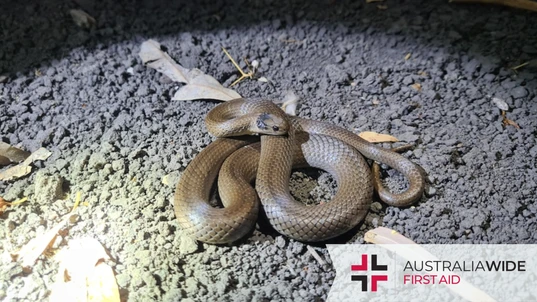All About the Little-Known Grey Snake

Bites and Stings

The Grey snake is a venomous member of the Elapidae snake family. They are known to inhabit woodlands and eucalypt forests in Queensland and New South Wales. Their venom contains procoagulants that can cause significant pain and swelling. (Photo Credit: Talia Schlen)
The Grey snake is one of the most elusive members of the Elapidae snake family. As they tend to forage on the ground between dusk and dawn, they have only been witnessed a handful of times over the past 65 years. Like other Elapids, such as the Eastern brown snake, the Grey snake is venomous. In this article, we will uncover all the mysteries of the Grey snake and teach you how to manage their bites. To learn more about identifying, treating, and preventing snake bites, enrol in one of our general or childcare first aid courses. We have training locations in every state, capital city, and major town throughout Australia - head to our website to enrol at a training location near you today.Appearance
The Grey snake (Hemiaspis damelii) has the following identifying characteristics:- The scales on their back and sides are uniformly olive to grey - in grey individuals, their scales may also be tipped with black anteriorly
- The scales on their belly can range from white to cream, sometimes with dark grey flecking
- They tend to have a dark stripe behind their head, though this can fade or disappear completely as the snake matures
- They have an average length of 50 centimetres, but can grow up to 70 centimetres
Distribution and Habitat
Though not much is known about the Grey snake's distribution, existing records indicate they are commonly found in south-eastern Queensland and north-central New South Wales. Small populations have also been found in south-western New South Wales and north-eastern South Australia. They tend to shelter in cracking clay soils and under rocks, logs, and other debris in woodlands and dry sclerophyll forests where water bodies are present.Behaviour
The Grey snake is mostly active during the night. They use this time to hunt and feed on frogs and skinks. They are currently listed as endangered under the Environment Protection and Biodiversity Conservation Act 1999. There are several factors contributing to their population decline:- Predation from feral animals like cats and foxes
- Habitat destruction from, and food competition with, feral pigs
- Ingestion of cane toads
Danger
The Grey snake has fairly mild venom that is unlikely to cause human fatalities. However, their venom contains procoagulants and can cause local pain and swelling. All snake bites should be treated as a medical emergency:- In line with the DRSABCD action plan, call Triple Zero (000) for an ambulance and be prepared to perform CPR
- Reassure the casualty, keep them under constant observation, and make sure they remain as still as possible
- Apply the Pressure Immobilisation Technique
- Immobilise the limb and joints with a splint until the ambulance arrives - use a sling for a bite to the arm
Final Thoughts
For hands-on experience with identifying, treating, and preventing snake bites, enrol in one of our general of childcare first aid courses. We have training locations in every state, capital city, and major town throughout Australia. Head to our website to find and enrol in a training location near you today.
Originally published at
https://www.australiawidefirstaid.com.au/resources/grey-snake
as part of the Australia Wide First Aid Articles Library









